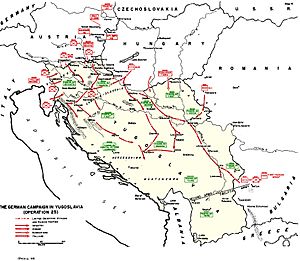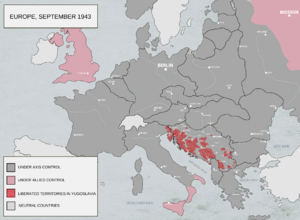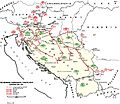Adriatic campaign of World War II facts for kids
Quick facts for kids Adriatic campaign |
|||||||
|---|---|---|---|---|---|---|---|
| Part of Mediterranean and Middle East Theatre of the Second World War | |||||||
 Adriatic Sea in 1941, during the Nazi invasion of Yugoslavia |
|||||||
|
|||||||
| Belligerents | |||||||
|
(from 8 September 1943) |
Axis: (until 1944) |
||||||
| Commanders and leaders | |||||||
|
|||||||
The Adriatic campaign of World War II was a series of naval battles and operations during World War II. It took place in the Adriatic Sea, involving navies from Greece, Yugoslavia, Italy, Germany, the United Kingdom, and France. Even though it was a smaller part of the war at sea, it had some interesting moments, especially because of the unique coastline of Dalmatia.
Contents
Early Conflicts in the Adriatic Sea
Italy Invades Albania (1939)
On April 7, 1939, Benito Mussolini's Italian troops took over Albania. They removed King Zog from power and made Albania part of the Italian Empire. The main naval activities were moving troops and supplies through ports like Taranto. Italian ships also fired cannons at the coast to help the soldiers land.
The Italian navy used many ships for this invasion. These included large battleships like the Giulio Cesare and Conte di Cavour. They also had cruisers, destroyers, and torpedo boats. These ships helped land troops at different Albanian ports.
When Italy joined World War II on June 10, 1940, its main naval bases in the Adriatic Sea were Venice, Brindisi, and Pola. These bases were important for controlling the northern and southern parts of the Adriatic.
Greco-Italian War (1940-1941)
The Greco-Italian War started on October 28, 1940, and lasted until April 30, 1941. It was another part of World War II. Italian forces tried to invade Greece but did not gain much ground.
At the start of the war, the Royal Hellenic Navy (Greece's navy) had an old cruiser called Georgios Averof. They also had ten destroyers, some torpedo boats, and six old submarines. The Greek navy was much smaller than the powerful Italian navy, the Regia Marina.
The Greek navy's main job was to patrol and protect convoys (groups of supply ships) in the Aegean Sea. This was vital for moving soldiers and supplies across Greece. Italian planes and submarines from the Dodecanese Islands often threatened these routes.
The Italian navy focused on moving supplies between Italy and Albania. They used older destroyers, torpedo boats, and other ships for these convoys. The main routes were from Brindisi to Valona and from Bari to Durres.
Greek submarines managed to sink some Italian transport ships. However, the Greek submarine force was too small to stop the flow of supplies. Between October 1940 and April 1941, Italian ships made thousands of trips. They carried hundreds of thousands of soldiers and tons of supplies. They lost only a few merchant ships and one escort ship during this time.
The British Royal Navy also played a role. On November 11-12, 1940, British ships attacked an Italian convoy in the Strait of Otranto. They sank four merchant ships and heavily damaged an Italian torpedo boat.
Axis Invasion of Yugoslavia (1941)
The Invasion of Yugoslavia began on April 6, 1941. It ended quickly on April 17 with Yugoslavia's surrender. The Axis powers (Germany, Italy, and Hungary) attacked and divided Yugoslavia.
When Germany and Italy attacked, the Yugoslav Royal Navy had only a few effective ships. These included three destroyers, two submarines, and ten motor torpedo boats. One destroyer, the Ljubljana, was being repaired and its anti-aircraft guns were used to defend the naval base at Kotor.
Yugoslav forces tried to attack the Italian area of Zara (Zadar) on April 9. However, Italian forces counter-attacked and pushed them back. The Yugoslav destroyer Beograd was damaged by Italian aircraft and had to retreat for repairs. Most of the smaller Yugoslav fleet was captured by Italian ground forces. Only a few ships escaped, like the submarine Nebojsa, which sailed to Allied ports. The destroyer Zagreb was sunk by its own crew to prevent it from being captured.
Italian Occupation and Yugoslav Resistance

After the invasion, Italy controlled the entire eastern Adriatic coast. They took over much of Dalmatia and set up puppet governments in Montenegro and Albania.
The Yugoslav Partisans formed their own naval forces early in the war, starting on September 19, 1942. They began with fishing boats in Dalmatia. Over time, especially after Italy surrendered to the Allies, their navy grew. It became strong enough to carry out complex operations. This is seen as the start of the modern Yugoslav Navy. At its strongest during the war, the Partisan Navy had about 10 armed ships, 30 patrol boats, and nearly 200 support ships. They also had coastal defenses and about 3,000 men.
After Italy surrendered to the Allies on September 8, 1943, the Partisans took control of most of the coast and islands. Their navy's job was to control the sea, defend the coast and islands, and attack enemy ships and forces.
British Submarine Operations
After Greece and Yugoslavia fell, Italy controlled both sides of the Adriatic Sea. This made it hard for British ships and planes to operate there. From 1941 to 1943, the British Royal Navy mainly used submarines in the Southern Adriatic. Italian convoys crossing the Adriatic lost very few ships during this time. Most of the losses they did have were caused by submarines, mainly British ones. Four British submarines were lost in the Adriatic, likely due to mines. British surface ships returned to the Adriatic after Italy surrendered in September 1943.
After Italy's surrender, the Germans quickly moved to take over the northern Adriatic ports like Trieste, Rijeka, and Pula. They set up a special military zone called the Operational Zone Adriatic Coast (OZAK) on September 10. This area included parts of Italy and Slovenia. The Germans expected an Allied landing here, so they sent many troops.
Joachim Lietzmann was the main German naval commander in the Adriatic. The German navy gradually grew, often using former Italian ships that were being built in shipyards. The strongest German naval unit was the 11th Sicherungsflotille. This unit protected German shipping from Partisan attacks.
One of the first German operations was Operation Herbstgewitter in November 1943. German troops landed on the islands of Krk, Cres, and Lošinj. They cleared the islands of Partisan forces.
Occupation of Dalmatia
By the end of 1943, German forces were moving into Dalmatia after Italy's surrender. Starting in late 1943, the Allies helped many civilians escape Dalmatia to avoid German occupation. They moved them to refugee camps in Egypt.
Vis Island: A Stronghold
By 1944, only the island of Vis remained free from German control. Yugoslav and British troops worked to prepare its defenses against a possible German invasion. The island was a strong fortress until the end of World War II.
Josip Broz Tito's headquarters moved to Vis in 1944. Over 1,000 British troops also helped defend the island. These British forces were called Land Forces Adriatic. They included special commando units and infantry. Several British Royal Navy ships operated from Vis. Tito's own forces numbered about 2,000. Vis became the main political and military center for the areas freed from Axis control until Belgrade was liberated later in 1944.
A notable person was Canadian Captain Thomas G. Fuller. In 1944, he commanded a British motor gunboat flotilla operating from Vis. He helped the Partisans by attacking German supply ships. He managed to sink or capture 13 German supply boats. He was known for using a loud hailer with a Yugoslav Partisan to threaten enemy crews, often making them surrender without a fight.
Liberating Dalmatia
British naval forces in the Middle East, operating in the Adriatic, worked closely with air attacks. The Yugoslavs used British navy units to move supplies and soldiers. They also used them to land troops on the Dalmatian islands to free them from German occupation.
From Vis, Partisans, with help from the Royal Navy and British commandos, carried out several landings on Dalmatian islands:
- Korčula
- Šolta – Operation Detained
- Hvar – Operation Endowment
- Mljet – Operation Farrier
- Brač – Operation Flounced
The French Navy also joined in during the first half of 1944. Their fast light cruisers attacked German convoys. In one important action, the Battle off Ist on February 29, 1944, French ships destroyed a German freighter and a corvette without any losses to themselves.
In the second half of 1944, the Royal Navy sent a destroyer group into the Adriatic. A major battle happened on November 1, 1944. Two British destroyers, Avon Vale and Wheatland, attacked two German corvettes. They quickly destroyed both German ships. Then, a German destroyer, TA20, appeared and was also sunk by the British ships.
The Adriatic campaign continued until the end of the war. Germany spread thousands of mines to block ports and canals in the northern Adriatic. British ships used special equipment to clear these mines. On May 5, 1945, a British mine-sweeping ship, Coriolanus, hit a mine.
Allied Plans for Landings
The Allies considered landing troops in the Adriatic area. Winston Churchill, the British Prime Minister, supported such a plan. However, the Americans were not convinced, so these large landing operations did not happen. Still, the British sent some air and artillery units to Dalmatia. These attempts stopped due to issues with Yugoslav cooperation.
The biggest British-led operation in the eastern Adriatic was Operation Antagonise in December 1944. It aimed to capture the island of Lošinj, where the Germans had fast attack boats. This operation was only partly carried out because the Partisan Navy Commander, Josip Černi, refused to send his troops for the landing. Instead, British destroyers and motor torpedo boats shelled German positions. South African planes also attacked the naval base. These attacks were repeated in early 1945.
By the end of October 1944, Germany still had several torpedo boats and corvettes in the Adriatic. Even in April 1945, some German ships were still active. Allied aircraft sank four German ships in port in March and April. A British motor torpedo boat sank TA45 in April.
The very last operations of the German navy involved evacuating troops from Istria and Trieste as the Yugoslavs advanced in May 1945. Thousands of German soldiers and their equipment were evacuated by ships. Many of these Germans surrendered to British troops who had arrived from Istria.
See Also
- List of ships of the Royal Yugoslav Navy
- List of ships of the Regia Marina
- List of ships of the Kriegsmarine
- List of ships of the Hellenic Navy
- List of ships of the Royal Navy
- List of ships of the French Navy
- List of ships of the Yugoslav Partisans Navy
Images for kids
-
Adriatic Sea in 1941, during the Nazi invasion of Yugoslavia



